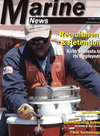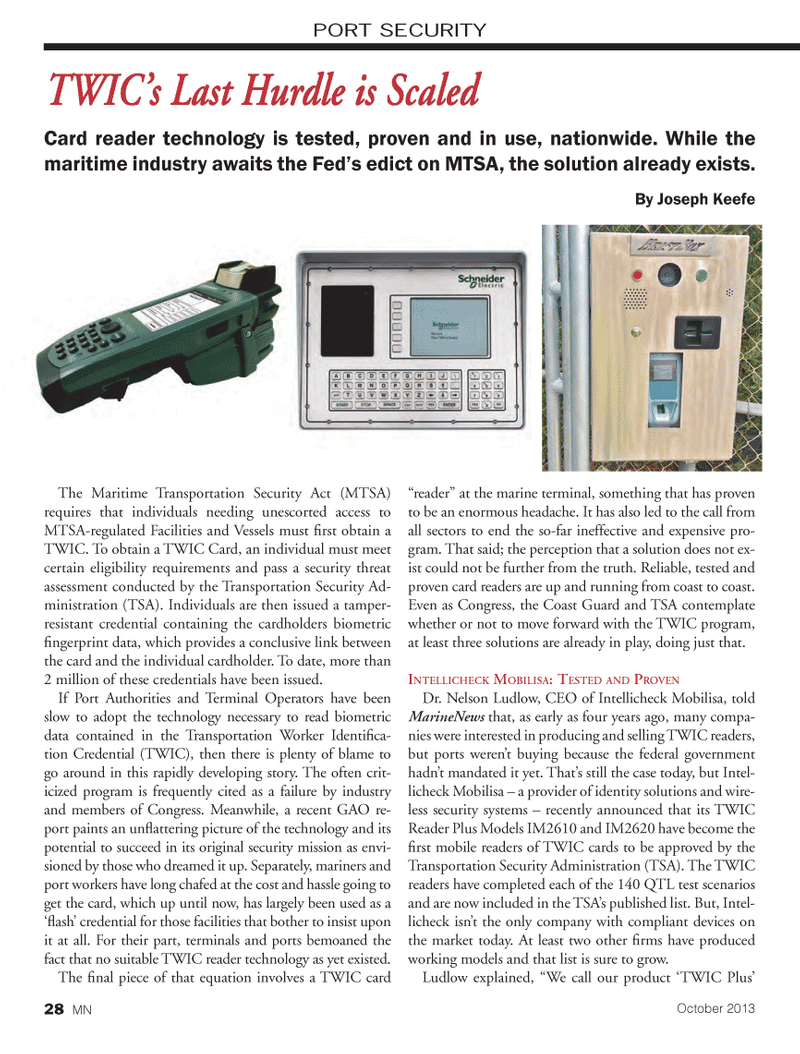
Page 28: of Marine News Magazine (October 2013)
Manning: Recruitment & Retention
Read this page in Pdf, Flash or Html5 edition of October 2013 Marine News Magazine
The Maritime Transportation Security Act (MTSA) requires that individuals needing unescorted access to MTSA-regulated Facilities and Vessels must Þ rst obtain a TWIC. To obtain a TWIC Card, an individual must meet certain eligibility requirements and pass a security threat assessment conducted by the Transportation Security Ad- ministration (TSA). Individuals are then issued a tamper- resistant credential containing the cardholders biometric Þ ngerprint data, which provides a conclusive link between the card and the individual cardholder. To date, more than 2 million of these credentials have been issued. If Port Authorities and Terminal Operators have been slow to adopt the technology necessary to read biometric data contained in the Transportation Worker IdentiÞ ca-tion Credential (TWIC), then there is plenty of blame to go around in this rapidly developing story. The often crit- icized program is frequently cited as a failure by industry and members of Congress. Meanwhile, a recent GAO re- port paints an unß attering picture of the technology and its potential to succeed in its original security mission as envi-sioned by those who dreamed it up. Separately, mariners and port workers have long chafed at the cost and hassle going to get the card, which up until now, has largely been used as a Ôß ashÕ credential for those facilities that bother to insist upon it at all. For their part, terminals and ports bemoaned the fact that no suitable TWIC reader technology as yet existed. The Þ nal piece of that equation involves a TWIC card ÒreaderÓ at the marine terminal, something that has proven to be an enormous headache. It has also led to the call from all sectors to end the so-far ineffective and expensive pro- gram. That said; the perception that a solution does not ex- ist could not be further from the truth. Reliable, tested and proven card readers are up and running from coast to coast. Even as Congress, the Coast Guard and TSA contemplate whether or not to move forward with the TWIC program, at least three solutions are already in play, doing just that. INTELLICHECK MOBILISA: TESTED AND PROVEN Dr. Nelson Ludlow, CEO of Intellicheck Mobilisa, told MarineNews that, as early as four years ago, many compa- nies were interested in producing and selling TWIC readers, but ports werenÕt buying because the federal government hadnÕt mandated it yet. ThatÕs still the case today, but Intel- licheck Mobilisa Ð a provider of identity solutions and wire- less security systems Ð recently announced that its TWIC Reader Plus Models IM2610 and IM2620 have become the Þ rst mobile readers of TWIC cards to be approved by the Transportation Security Administration (TSA). The TWIC readers have completed each of the 140 QTL test scenarios and are now included in the TSAÕs published list. But, Intel- licheck isnÕt the only company with compliant devices on the market today. At least two other Þ rms have produced working models and that list is sure to grow. Ludlow explained, ÒWe call our product ÔTWIC PlusÕ PORT SECURITYTWIC?s Last Hurdle is Scaled TWIC?s Last Hurdle is Scaled Card reader technology is tested, proven and in use, nationwide. While the maritime industry awaits the Fed?s edict on MTSA, the solution already exists. By Joseph Keefe October 201328 MNMN October2013 Layout 18-31.indd 28MN October2013 Layout 18-31.indd 289/30/2013 11:25:02 AM9/30/2013 11:25:02 AM

 27
27

 29
29
